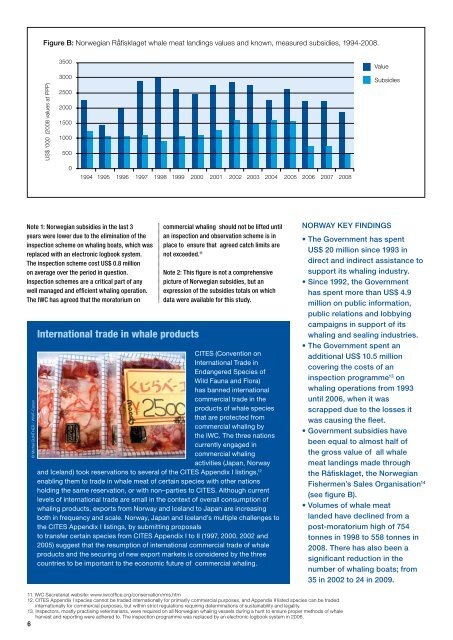The Economics of Whaling Today - WWF
The Economics of Whaling Today - WWF
The Economics of Whaling Today - WWF
Create successful ePaper yourself
Turn your PDF publications into a flip-book with our unique Google optimized e-Paper software.
-25.00<br />
-30.00<br />
88/89<br />
89/90<br />
90/91<br />
91/92<br />
92/93<br />
93/94<br />
94/95<br />
95/96<br />
96/97<br />
97/98<br />
98/99<br />
99/00<br />
00/01<br />
01/02<br />
02/03<br />
03/04<br />
04/05<br />
05/06<br />
06/07<br />
07/08<br />
08/09<br />
Figure B: Norwegian Råfisklaget whale meat landings values and known, measured subsidies, 1994-2008.<br />
US$ ‘000 (2008 values at PPP)<br />
3500<br />
3000<br />
2500<br />
2000<br />
1500<br />
1000<br />
500<br />
Value<br />
Subsidies<br />
0<br />
1994<br />
1995 1996 1997 1998 1999 2000 2001 2002 2003 2004 2005 2006 2007 2008<br />
Note 1: Norwegian subsidies in the last 3<br />
years were lower due to the elimination <strong>of</strong> the<br />
inspection scheme on whaling boats, which was<br />
replaced with an electronic logbook system.<br />
<strong>The</strong> inspection scheme cost US$ 0.8 million<br />
on average over the period in question.<br />
Inspection schemes are a critical part <strong>of</strong> any<br />
well managed and efficient whaling operation.<br />
<strong>The</strong> IWC has agreed that the moratorium on<br />
© Michel GUNTHER / <strong>WWF</strong>-Canon<br />
International trade in whale products<br />
commercial whaling should not be lifted until<br />
an inspection and observation scheme is in<br />
place to ensure that agreed catch limits are<br />
not exceeded. 11<br />
Note 2: This figure is not a comprehensive<br />
picture <strong>of</strong> Norwegian subsidies, but an<br />
expression <strong>of</strong> the subsidies totals on which<br />
data were available for this study.<br />
CITES (Convention on<br />
International Trade in<br />
Endangered Species <strong>of</strong><br />
Wild Fauna and Flora)<br />
has banned international<br />
commercial trade in the<br />
products <strong>of</strong> whale species<br />
that are protected from<br />
commercial whaling by<br />
the IWC. <strong>The</strong> three nations<br />
currently engaged in<br />
commercial whaling<br />
activities (Japan, Norway<br />
and Iceland) took reservations to several <strong>of</strong> the CITES Appendix I listings, 12<br />
enabling them to trade in whale meat <strong>of</strong> certain species with other nations<br />
holding the same reservation, or with non–parties to CITES. Although current<br />
levels <strong>of</strong> international trade are small in the context <strong>of</strong> overall consumption <strong>of</strong><br />
whaling products, exports from Norway and Iceland to Japan are increasing<br />
both in frequency and scale. Norway, Japan and Iceland’s multiple challenges to<br />
the CITES Appendix I listings, by submitting proposals<br />
to transfer certain species from CITES Appendix I to II (1997, 2000, 2002 and<br />
2005) suggest that the resumption <strong>of</strong> international commercial trade <strong>of</strong> whale<br />
products and the securing <strong>of</strong> new export markets is considered by the three<br />
countries to be important to the economic future <strong>of</strong> commercial whaling.<br />
NORWAY Key Findings<br />
• <strong>The</strong> Government has spent<br />
US$ 20 million since 1993 in<br />
direct and indirect assistance to<br />
support its whaling industry.<br />
• Since 1992, the Government<br />
has spent more than US$ 4.9<br />
million on public information,<br />
public relations and lobbying<br />
campaigns in support <strong>of</strong> its<br />
whaling and sealing industries.<br />
• <strong>The</strong> Government spent an<br />
additional US$ 10.5 million<br />
covering the costs <strong>of</strong> an<br />
inspection programme 13 on<br />
whaling operations from 1993<br />
until 2006, when it was<br />
scrapped due to the losses it<br />
was causing the fleet.<br />
• Government subsidies have<br />
been equal to almost half <strong>of</strong><br />
the gross value <strong>of</strong> all whale<br />
meat landings made through<br />
the Råfisklaget, the Norwegian<br />
Fishermen’s Sales Organisation 14<br />
(see figure B).<br />
• Volumes <strong>of</strong> whale meat<br />
landed have declined from a<br />
post-moratorium high <strong>of</strong> 754<br />
tonnes in 1998 to 558 tonnes in<br />
2008. <strong>The</strong>re has also been a<br />
significant reduction in the<br />
number <strong>of</strong> whaling boats; from<br />
35 in 2002 to 24 in 2009.<br />
11. IWC Secretariat website: www.iwc<strong>of</strong>fice.org/conservation/rms.htm<br />
12. CITES Appendix I species cannot be traded internationally for primarily commercial purposes, and Appendix II listed species can be traded<br />
internationally for commercial purposes, but within strict regulations requiring determinations <strong>of</strong> sustainability and legality.<br />
13. Inspectors, mostly practising veterinarians, were required on all Norwegian whaling vessels during a hunt to ensure proper methods <strong>of</strong> whale<br />
harvest and reporting were adhered to. <strong>The</strong> inspection programme was replaced by an electronic logbook system in 2006.<br />
6

















